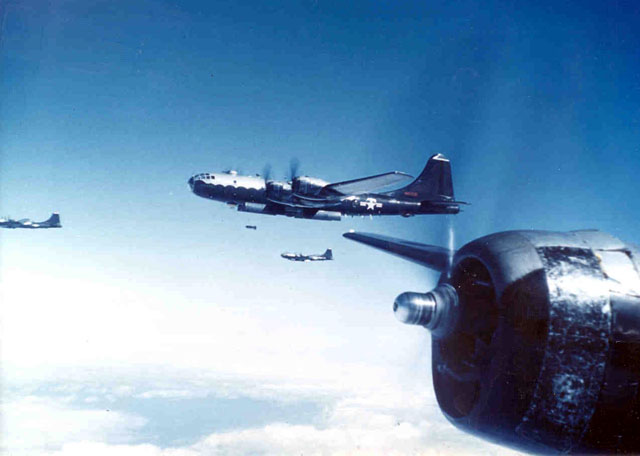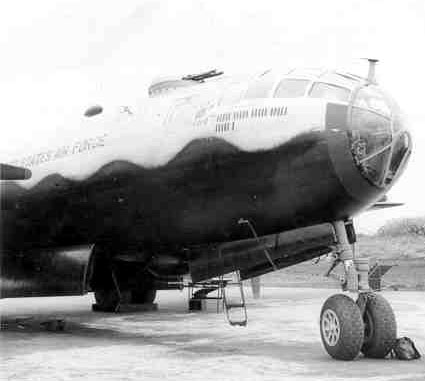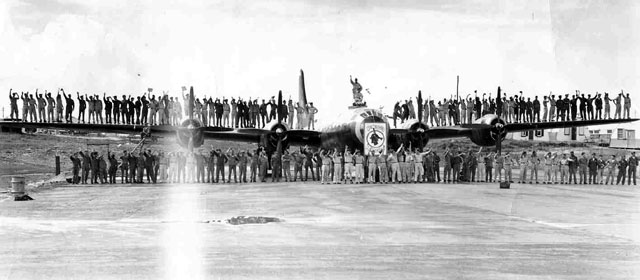|
B-29 In Korea
by Ted Kalogeris
|

|
|
B-29 Superfortresses of the
28th Bomb Squadron, 19th Bombardment Group
Over Korea |

HyperScale is proudly supported by Squadron
My father was a pilot in the US Air Force during the last year of the Korean
War. He flew as both pilot and co-pilot in B-29’s in the 28th Bomb Squadron of
the 19th Bombardment Group, based at Kadena on Okinawa.
His group flew both strategic and tactical interdiction missions against
enemy targets in North Korea.
Near the end of his tour he had saved up enough money to buy a camera at the
base PX. It was a 35 mm Argus C3. We had this camera around the house when I was
growing up - it was a real beauty. He took his camera along on one of the last
missions of his tour, shooting about 30 Kodachrome slides of the mission—on the
ground before takeoff, on the way to the target, passing by Mt Fuji, and during
the bomb run.

Kodachrome slides last virtually forever when stored properly, and these have
been well cared for, so the color on them is fantastic. About 15 years ago, I
had 8 x 10 prints made of several of these slides, and two of the best of these
are the ones you see here. In one of them (above) you can clearly see a bomb
falling from the forward bay of the nearest ship. Just below that in the picture
there are at least 5 or 6 bombs visible falling from the furthest aircraft. In
both you can see the general color scheme of topside NMF finish and black
undersides, with the black extending to both top and bottom of the entire
tailsection aft of the rear dorsal gun turret.
 There are
also two black and white shots; one is of the nose of my father’s ship. Just aft
of the mission markings, is the plane’s logo and name, “Our Lemon.” There are
also two black and white shots; one is of the nose of my father’s ship. Just aft
of the mission markings, is the plane’s logo and name, “Our Lemon.”
The other B&W is a group shot of all aircrew personnel of the 28th Squadron
in front of and on one of the units’s planes. I call your attention to two
individuals: the first is my father, 1st Lt. John G. Kalogeris, who is sitting
on the forward top turret; the second is another “gentleman” officer standing
one man away from the outboard engine on the right wing, who, instead of waving
like everyone else, is clearly offering the ol’ one-fingered salute to the
photographer.
For those with an interest in aerospace history, my father first learned how
to fly in the early-mid ‘40’s in New York in Piper Cubs. He joined the Air Force
in ’49 or ’50, did his primary and advanced pilot training in AT-6’s at
Bainbridge, GA in 1950-51, transitioned to multi-engine, first in B-25’s and
then to B-29’s in Waco, TX, then after Korea, flew all over the world—Europe,
Asia, Africa, etc., doing ferry work, weapons training and instructing, and
finally transitioned to jets. Other than T-6’s, B-25’s and B-29’s, his logbook
shows time in the L-2, C-45, C-47, B-36, B-47, C-54, P-61 (this last to ferry
the ship to Eglin AFB, where it was to be used as a napalm target in weapons
testing—enough to make any P-61 fans out there weep), F-84, and T-33. I was born
in 1955 on base at Smokey Hill AFB in Salina, KS; my father was off somewhere in
a B-47 on a SAC airborne alert.

He got out of the Air Force in 1955, just as the B-52 was becoming
operational, so he had no recorded hours in this type. He next took a job as an
aeronautical engineer for Convair, and headed up a design and testing team that
worked on the pilot ejection seat for the F-102 and F-106. I have vague
recollections from when I was about 2, of riding in the back of a ten-wheeler
with my mother out into the desert to see a run of the rocket sled that my Dad’s
team used for ejection seat testing—this thing ran on rails and got up to about
500 mph, then the seat would blast out with a dummy strapped into it. All I
remember seeing was a big puff of white smoke about 1-2 miles away. I have nice
shots of the sled in action, an airborne ejection test from an F-106 and a group
shot of my Dad (wearing his 28th Bomb Squadron baseball cap) with his test group
in front of one of their rocket sleds. And somewhere, I have a sequence of shots
of an unsuccessful test, with my father visible in the foreground observing,
crouched down pretty damn close alongside the track, as the sled begins to
disintegrate during its run—as the sequence progresses, it is clear that my Dad
has gotten his ass the hell out of there, and the sled explodes into tiny (and
not so tiny) pieces.
After that project, my Dad next worked at Convair/General Dynamics plants in
San Diego, first at a facility located on Lindbergh Field, then at the newer,
Astronautics Division facility in Kearny Mesa—mainly on the Atlas/Agena launch
vehicle program extending through the Mercury and Gemini programs. Then he left
and went into the building business. But he still flies—has a commercial
license, and he’s the one who got me into both flying and models. While in the
Air Force he used to build enormous, 1/16 or 1/12 scale control line gas engine
planes—when I was a kid we had 3 almost finished ones hanging in our
garage until my brother and I pestered him to finish them and take them flying—a
C-47, a P2V Neptune, and, of course, a B-29.
I can remember us going out into the schoolyard with my Dad, and hearing him
cuss out those .60’s on the B-29—every time he got a couple of ‘em going, he’d
then get the third one started and one or both of the first two would stop. This
went on for what seemed like years until he finally got all 4 of ‘em going, then
as I held it down, he ran out to the end of the line and told me to let go. That
monster rolled away, got off the ground for about a half a turn, then pancaked
hard. For the rest of my childhood, what was left was hanging in the garage.
One last attempt at doing flying models cured me of this frustrating version
of aero-modelling. In Junior High and High School, my brother and I collaborated
for 8 months on a 1/16 scale, RC Mosquito—it was beautiful, and on its first
flight it bit the big one. I decided that it was just too hard to spend all that
time building a plane only to have it virtually destroyed straight away.
It’s been static plastic ever since!
Text & Images Copyright ©
2001 by Ted Kalogeris
Page Created 22 November, 2001
Last Updated
19 April, 2004
Back to Reference Library
|
Home |
What's New |
Features |
Gallery |
Reviews |
Reference |
Forum |
Search